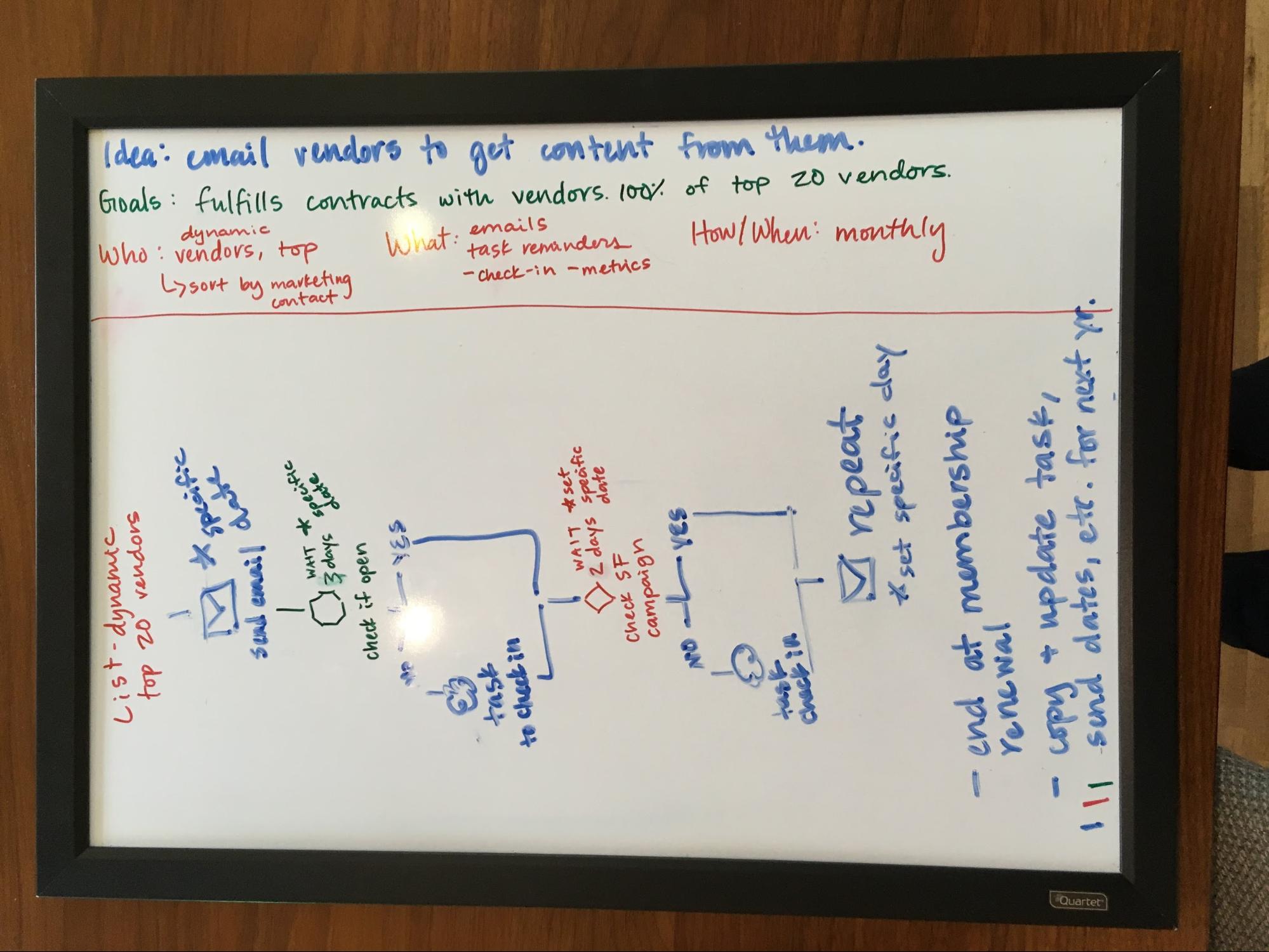Marketing Cloud Account Engagement 101: Engagement Studio
In this Marketing Cloud Account Engagement 101 article, we will cover what makes up Engagement Studio, common use cases, and considerations for creating a program. We’ve also included an exercise we’ve found very successful with clients on how to map out your Engagement Studio program with your team.
However, once you’ve mapped out your program, we won’t be walking you through the easy part- creating it in Marketing Cloud Account Engagement (powered by Pardot). There are lots of additional resources online for that, check them out here.
To start, let’s use a real-life example
We’ll start from the prospect’s point of view. As you begin to build out your own Engagement Studio programs, you’ll want to consider how your prospects will engage with your programs.
Ask yourself how many touch points you think they need versus how many they want. You don’t want to scare away your leads by being too aggressive at the beginning or sending emails too frequently.
Let’s dive into a scenario of how Marketing Cloud Account Engagement (MCAE)'s Engagement Studio works from the view of a prospect:
1. You’ve just signed up for a whitepaper. You were redirected to a thank you page and an email with a link to download a copy of the whitepaper PDF lands in your inbox. You spend the next few days reading through the whitepaper and doing more research.
2. A couple of days after downloading the whitepaper, you receive a follow-up email asking if you have questions about the topic of the whitepaper. Early the next week you receive a highly personalized email sending you more information and resources on the topic of the whitepaper.
3. Finally, after two weeks, you get a call from the company who produced the whitepaper- they’re asking you how your research is going. They've researched your company and asked relevant questions. You set up a time to talk with one of their sales reps. Your research has prepared you to make a purchase.
This is an ideal scenario of how your prospects will view your Engagement Studio program, and ideally the outcome of the Engagement Studio program.
So, what is Engagement Studio and how does it work?
At its core Engagement Studio is a lead nurturing tool that incorporates email marketing for a highly personalized experience based on your data and your prospect’s activities with your digital assets. The usual goal is to get them to convert by leading them through a journey of engagements.
While every marketing automation solution calls their Engagement Studio equivalent something different, they all include logic (questions answered with a yes or no) and the ability to schedule actions and automate your follow-up.
Engagement Studio lets you build what are known as programs for this logic. Basically, a program is a journey map of the steps you want to happen. Here’s what a simple program looks like.
For a high-level overview of Engagement Studio check out this one-minute demo video from MCAE.
What are Engagement Studio programs?
In a simple answer, they are advanced drip campaigns.
Along with email marketing, drip campaigns are the bread and butter of marketing automation platforms. But how do they work and how do MCAE’s offerings stand out?
Depending on your MCAE license you could create up to 20 programs (Standard edition) or 50 programs (Professional edition and higher).
Steps available in Engagement Studio Programs
Your Engagement Studio programs are made of a series of steps. You can have hundreds of steps, but it’s suggested you keep it to 300 or less. And from my experience, the less the better. Keep it simple.
You can take 4 different types of steps: Triggers, Actions, Rules, and Stops.
Triggers, as known as the “listen for something” step, check for a prospect to complete an engagement with your MCAE assets, such as filling out a form. Here’s a complete list of Triggers available in MCAE:
- Email Open
- Email Link Click
- Form View or Submission
- Landing Page View or Submission
- Custom Redirect Click
- File Download
Actions, or the “do something” step, are pretty straightforward. You choose to take an action with the prospect record or engage the prospect in some way. My favorite action is the “Create a Salesforce Task”, to automate tasks for Sales to follow up with a prospect. Here’s a complete list of the actions available in Engagement Studio programs:
- Add to List
- Add to Salesforce Campaign
- Adjust Score
- Apply Tags
- Assign to Group
- Assign to User
- Assign to Salesforce Active Assignment Rule
- Create Salesforce Task
- Change Prospect Field Value
- Notify User
- Remove from List
- Remove Tags
- Send Email
Rules, also known as the “check for something” step, allow you to check a field on a prospect’s record. A common use case is to check if a prospect has a high score or grade. Here are all the things you can check via the Rule step in MCAE's Engagement Studio:
- Assigned Salesforce Queue
- Assigned User
- Assignment Status
- Grade
- List
- Prospect Custom Field
- Prospect Default Field
- Score
- Prospect Tag
- Salesforce Campaign
- Salesforce Campaign Status
- Prospect Email Status
- MCAE Campaign
- Salesforce Status
Stops are exactly as they sound. It’s an end path. A good example of how you could use this: you want anyone who opens an email or registers for a webinar to stop moving through the Engagement Studio program.
What about time in Engagement Studio?
Alongside creating the steps, you can choose when to take those steps. Most steps allow you to wait a certain amount of days (for example, 4 days) or perform the step immediately.
Recently, MCAE added the availability for you to pick a specific date for the email send steps to take place. You should know that if someone gets to this step after the set date has passed, they will not get the email, but they will move forward in the program.
One of the most common questions I get from MCAE users is what happens when I pause a program. It does exactly that, it pauses. Your prospects will not receive emails or move forward in your program. When you hit “Start” your program will begin again. So if a prospect hit a step with a wait time of 5 days and you clicked pause on their first day, they will wait for 4 more days once you start the program back up.
Have more questions about how time works in MCAE? You can read more in this MCAE help article.
Common uses for MCAE's Engagement Studio
There are some really creative ways to use MCAE Engagement Studio programs. But, again, it’s best to keep it simple- at least in the beginning.
Here are the most useful, and common, ways we’ve seen Engagement Studio programs used for clients when they first start with Marketing Cloud Account Engagement.
Resource follow up
This usually lasts up to a month. It’s mainly comprised of sending email steps to prospects and offering them more information on the subject of the whitepaper, webinar, or online content. This typically ends with a task for your internal Sales or Business Development team to follow up with the prospect, if they continued to show interest that is.
Welcome series
This typically lasts no more than a month. The main purpose is to send emails to new prospects who have opted-in to introduce them to your brand. My favorite version of this is for the internal onboarding of new hires. It’s a great way to get cross-departmental support for MCAE.
Re-engagement and/or a Goodbye series
MCAE has great documentation on how to get started finding out who in your MCAE instance is not engaged with your content. Using this documentation, you can create a series of emails to re-engage and/or one final email to let them know you will be opting them out of your communications (unless they take action to remain engaged).
I know removing prospects can be a tricky conversation to have with your team, but ultimately this step helps you keep your MCAE instance clean, your email deliverability high, and could even save you money by reducing the number of prospects in your instance. (Sorry MCAE, but it’s true.)
Some considerations before you build out a program
If you’re sending emails in your program (not all do), you’ll need to create content, email templates, and maybe even fields for this to work. So many companies want a lead nurturing program but don’t have the content to fully execute this.
Take a look at your content and consider where each piece of content falls into your customer’s journey before moving forward with a lead nurturing Engagement Studio program.
You’ll also want to look at how your team uses Salesforce and MCAE to make sure you’re using tasks in Salesforce or following best practices for data quality.
MCAE has a full list of considerations. I highly suggest reviewing them before creating your first program.
Now let’s create an Engagement Studio Program together!
First, schedule a meeting with your team. Brainstorm a few simple ways you could best use MCAE's Engagement Studio. Then pick one that would be easy and effective.
Next, using paper, a whiteboard, or a diagramming tool like Gliffy, map out your team’s thoughts using the following questions.
What’s your overall idea for the program?
We’ll use an example similar to the one at the beginning of this post.
Example: Our goal is to nurture qualified prospects who have downloaded a whitepaper through our sales funnel.
In this case, a qualified prospect means someone who fits your ideal client or audience.
Why is this idea relevant to your business goals?
You might have some specific business goals outlined. Try to tie your program to those goals as much as possible. This helps with executive buy-in and keeps your program on course with your organization.
Example: Driving revenue and increasing conversions of our qualified leads interested in the whitepaper’s topic.
What’s your ultimate end goal?
Like a call to action, you need an end goal. What action do you want these prospects to take at the end?
Example: I want my prospects to schedule a call with our Business Development Rep to discuss the whitepaper’s topic and their needs.
Next, break your idea down into what you’ll need from MCAE to make this work.
Outline the following MCAE items:
Lists. Who do we want to email? Who do we want to suppress?
Assets. Are there landing pages, forms, emails, or files that need to be checked, sent, or tracked in some way with this program?
Steps. What steps and actions need to be taken? And in what order? While I list all the steps available above, you can also find them here.
Time. When will this begin and end?
This doesn’t have to be pretty or done in a fancy tool first. In a recent Portland MCAE user group meeting, we decided to test my strategy using a small whiteboard. We guided a user through these questions and then outlined what she’d need to make this work.
Here’s what our user group member’s program looked like:

And there you have it. I hope this long article helps you prep for using Engagement Studio. It’s one of my favorite tools in MCAE. But it will need some thoughtful planning before you use it.
Need some Marketing Cloud Account Engagement help?
We’re always up to chat with MCAE users who want to optimize their instance. If you’re looking to audit your MCAE instance and get recommendations or even get your team trained to use the tool better, we’ve built our services for you. Click the button below to reach out to us.
















